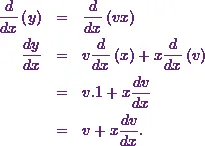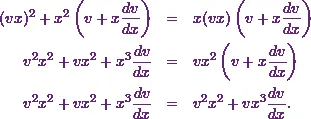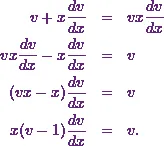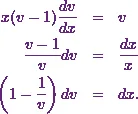First-Order Homogeneous Ode
WHAT IS A FIRST-ORDER HOMOGENEOUS ODE?
Now any differential
equation with  is a first-order ODE.
This type of equation does not have any higher-order derivative.
is a first-order ODE.
This type of equation does not have any higher-order derivative.
Next is Ďhomogeneous.í
Now any first-order ODE is homogeneous if the total degree for each term is the same.
For example,  is a first-order homogeneous
ODE. This is because each term has a degree 1.
is a first-order homogeneous
ODE. This is because each term has a degree 1.
Again,  is also a first-order homogeneous
ODE. This is because each term has a total degree as 2.
is also a first-order homogeneous
ODE. This is because each term has a total degree as 2.
But  is not a homogeneous ODE. This
is because each term does not have the same degree.
is not a homogeneous ODE. This
is because each term does not have the same degree.
HOW CAN I SOLVE A FIRST-ORDER HOMOGENEOUS ODE?
Now there is a standard method to solve any first-order homogeneous ODE.
That is,
Choose  .
.
Replace  and
and  with
with  and
and  respectively.
respectively.
Solve the equation.
Bring back  .
.
Next, I will solve an example on the first-order homogeneous ODE.
EXAMPLE
According to Stroud
and Booth (2013)* ďFind the general solution of  Ē
Ē
SOLUTION
Here the given ordinary differential equation (ODE) is:
![\[y^2+ x^2\cfrac{dy}{dx} = xy \cfrac{dy}{dx}.\]](7_files/image010.webp)
This equation has
only  and no
and no  Hence this is a
first-order ODE.
Hence this is a
first-order ODE.
Now, in this
equation, each term has a total degree of  .
.
For example,  has
a degree
has
a degree  .
.
Similarly,  has
the same degree of
has
the same degree of  .
.
But the term  has
the total degree as
has
the total degree as  . This is because
. This is because  has a degree of
has a degree of  and
and  also
has a degree of
also
has a degree of  .
.
So together
itís  .
.
Thus I can say that this is a homogeneous equation.
Now Iíll solve this equation using the same method as Iíve described above.
STEP 1
First of all, Iíll give this equation a number, say,
Now I choose  .
.
Therefore, Iíll
differentiate  with respect to
with respect to  . For that, Iíll use
the product rule of differentiation.
. For that, Iíll use
the product rule of differentiation.
Thus it will be

Now Iíll
substitute  and
and  in equation (1).
in equation (1).
Thus it will be

Now Iíll simplify it to get

Next Iíll
cancel  to get
to get

Now I can see that
each term also has  as a common term.
as a common term.
So Iíll take that out like

Since  I
can cancel that from both sides of the equation.
I
can cancel that from both sides of the equation.
Thus it becomes
Itís not possible to simplify it any more.
So now my job is to solve it.
STEP 2
First of all, Iíll
take the  term on one side.
term on one side.
So equation (2) will be

Now itís very clear
that I can separate  and
and  variables to solve the
equation.
variables to solve the
equation.
In other words, Iíll use Ďseparation of variablesí method to solve this equation.
Therefore the equation will be

Now Iíll integrate
both sides of the equation to get  .
.
Thus it will be

So this gives
![\[v - \ln v &=& \ln x + \ln C.\]](7_files/image032.webp)
Here  is
the integration constant.
is
the integration constant.
As a next step, Iíll
bring back  in the solution.
in the solution.
STEP 3
Next, Iíll
replace  with
with  .
.
So it will be
![\[\frac{y}{x}- \ln \frac{y}{x} = \ln x + \ln C.\]](7_files/image035.webp)
Now Iíll bring logarithmic expressions on one-side.
Therefore it becomes
![\[\frac{y}{x} = \ln x + \ln C + \ln \frac{y}{x}.\]](7_files/image036.webp)
Next, Iíll work on the logarithmic functions of this solution.
As I already
know  , I can say
, I can say  .
.
So the equation will become

Next Iíll take anti-logarithm on both sides.
Thus it will be

Here 
Hence I can conclude
that the general solution of the equation is 
This is the answer to this example.

